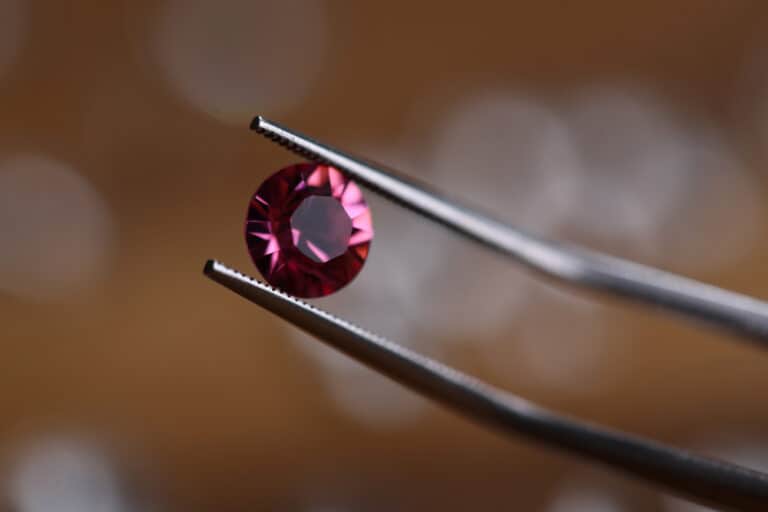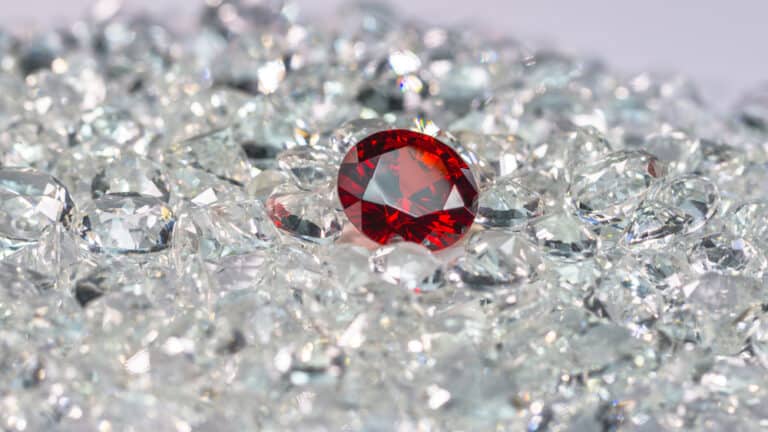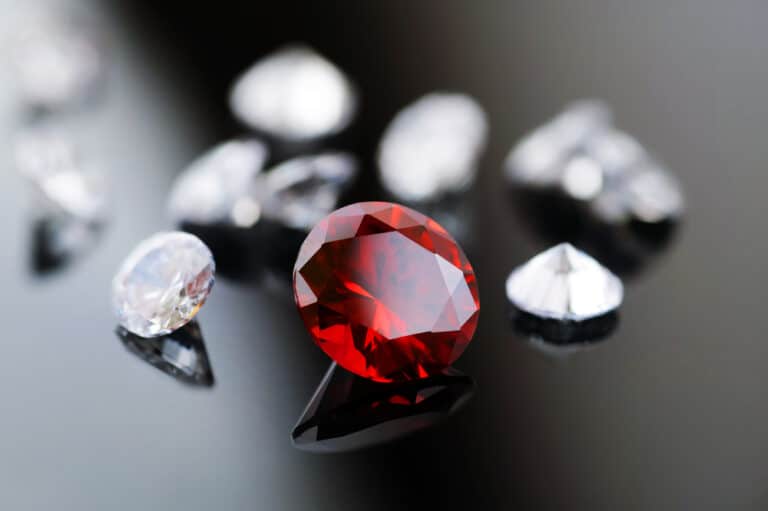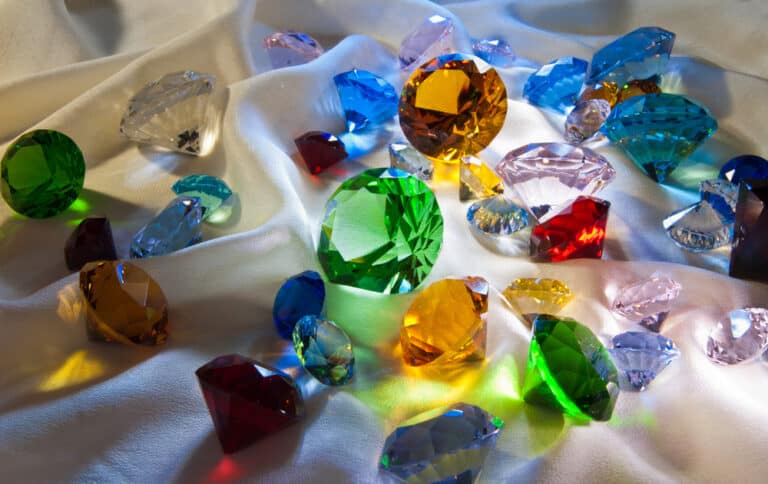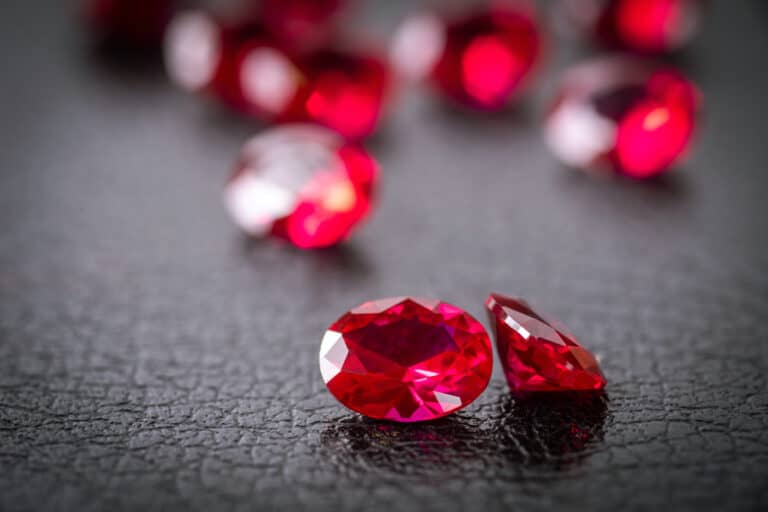Rubies are one of the rearrest, most beautiful, and most expensive gemstones known to man. Usually, rubies are considered a striking red color, although their durability, hardness, rarity, and luster are the gemstones main distinguishing features. It is known that rubies are extraordinarily expensive; however, their price is known to vary depending on their carat weight and stone quality.
Some rubies cost as little as $1, while others can go for up to $100.000. The price of a ruby gemstone is dramatically influenced by its overall carat weight and quality. A ruby’s quality is indicated by its color, although its clarity, carat weight, and cut are also determining factors.
High-quality rubies can fetch a staggering amount of money in global markets. A ruby’s price is determined by a professional that analyses the stone within a specific set of criteria before determining its desirability. Despite varied factors influencing the price, it is said that the gemstone’s color is the driving force behind the entire industry.
How Much Does One Carat Of Ruby Cost?
For the past few centuries, gemstones have obtained their monetary value through their defined quality. This means that the price of one carat is not standardized and can significantly vary.
In global jewelry markets, a carat is a measurement used to quantify the weight of a tiny object, which is usually rare, expensive, and desirable. A ruby gemstone is one of the rarest substances ever discovered, globally revered for its durability, versatility, hardness, and rarity. However, the quality of rubies mined in various regions of the world is different, leading to a price discrepancy.
A low-quality ruby, which is easy to come by in rivers, desert areas, or dedicated mines, can be traded for as little as $1. Conversely, a high-quality untreated ruby can generate an astronomical monetary amount, with some going for more than $100.000.
The enormous price difference for one carat or ruby gemstone is due to the ranking system utilized by renowned jewelry houses, investment firms, and mining companies. Once a ruby has been placed on sale, an industry professional will rank the gemstone in its color, clarity inclusions, cut, and carat weight.
The price for one carat of ruby is exclusively determined by the four factors mentioned above, which are then sold to individuals at a value indicative of current global demand. However, there are other considerations regarding the gemstone’s eventual selling price, such as international customs, treatment processes, and the given rarity of its desirable characteristics.
While all the factors regarding the cost of one carat of ruby are influential, the gemstone’s color is more important and is often the deciding factor. If an untreated ruby gemstone displays different shades of red, it is far more desirable for global trading markets.
Industry experts agree that ruby’s red color is its main separating factor, with others claiming that it is the major driving force behind the entire industry. High-quality rubies are primarily red, although a dark or medium red tint remains permissible even if it is not as desirable as a deep red color.
What Is The Average Price Of One Carat Of Ruby?
As a general industry rule, one carat of ruby is worth in the region $1000. However, the value of one carat of ruby can easily skyrocket when they have not undergone any heat treatment.
The baseline price of $1000 for one carat of ruby can dramatically increase when the gemstone has not been heat-treated and demonstrates a desirable red color. In addition, any ruby that weighs more than one carat will be exponentially more expensive as these red gemstones are far rarer and more challenging to mine.
Big gemstones are usually associated with far higher prices due to their rarity and mining difficulties. However, this rule is additionally applicable to rubies as they are among the rarest substance known to man and are mainly found in sizes of two carats or less.
In comparison, untreated diamonds and sapphires weighing more than 100 carats are regularly mined in different regions of the world, which decreases their associated rarity and consumer demand. High-quality rubies are never found in such large singular amounts since chromium, responsible for the gemstone’s red color, does not easily bond and react with corundum.
Since rubies are most commonly discovered in tiny quantities, the gemstone’s rarity factor is extraordinarily high. This means that the price of a carat of ruby is far greater than any comparable gemstone such as diamonds or sapphires. However, even at lower carat weights, ruby remains pricier than its competitors due to its known hardness, durability, luster, and intense red color.
How Is The Value Of Ruby Determined?
Industry professionals determine the value of one carat of ruby using a specific quality assessment procedure, commonly demonstrated in diamond and sapphire evaluations.
The four criteria used in the valuation process of ruby gemstones are color, clarity, carat weight, and cut. The same well-defined process is used in diamond and sapphire evaluations; However, the procedure is more challenging for ruby evaluation since the gemstone currently lacks an industry-accepted quality standard.
It is more arduous and contentious to determine a ruby gemstone’s real value than diamonds or sapphires since rubies are faced with a separate set of standards. The variation in usual price-determining evaluation standards is since rubies increase in value according to their color, which is the gemstone’s most important and distinctive characteristic.
Industry experts agree that ruby is the rarest gemstone currently utilized in the global jewelry trade and financial markets. Rubies are enormously challenging to locate and mine due to their minute size. Unlike other gemstones such as diamonds, untreated rubies are mostly found in weights of less than one carat. Untouched rubies weighing more than one carat are extraordinarily rare and will fetch more than $100.000 throughout appropriate global markets.
Color
a ruby gemstone’s color is the most important characteristic regarding its price per carat. However, determining the precise color remains challenging as it leaves room for interpretation.
Currently, the color of a ruby gemstone is described in terms of its tone, hue, and saturation. Moreover, the perfect ruby gemstone is a vivid dark or medium red with occasional hints of purple. The hue of a ruby is the most critical factor in determining its price for the market, with the most desirable colors mainly being found in Burma.
Most people cannot afford the highest quality ruby, meaning that they must settle for a gemstone that is a combination of red and yellow. While the yellow tinges are not the rarest form of ruby, many prefer the aesthetic and the substantially reduced price. However, it should be noted that lower-quality rubies will eventually become pink sapphires due to their chemical makeup.
Clarity
Ruby gemstones are not known for their clarity. High-quality and low-quality rubies have notable fissures, which is different to clear diamonds.
Rubies that are completely clear to the naked eye and through a magnification device should be viewed with suspicion as the inclusions result from how the crystal was grown. Experts agree that the market value of a ruby gemstone is slightly influenced by its clarity to the naked eye.
While a ruby’s clarity can be a critical factor to some people, it remains insignificant compared to the importance of its color. The most expensive type of ruby gemstone, known as the star ruby, is nearly opaque. This demonstrates the irrelevance of clarity in ruby gemstone valuations, which is the opposite of other rare gemstones such as diamonds and sapphires.
Carat Weight
The price of a ruby is directly impacted by its size and weight. However, as the weight and size of the ruby increase, so does the price per carat.
Consumers are used to paying less per unit when buying in bulk. However, ruby gemstones are rarely found in sizes larger than one or two carats meaning that the price per carat soars as the gemstones’ weight increases.
It should be noted that rubies have a different gravitational pull compared to other gemstones such as diamonds meaning that they are usually smaller despite weighing the same.
Cut
The cut of a ruby gemstone directly influences the price it’s sold on the market. Rubies can be cut in many different shapes, styles, or finishings depending on how it was found and the consumer’s demands.
Moreover, the cut of a ruby can indicate the overall symmetry or dimensions of the gemstone influences its final selling price. In direct contrast with diamonds, rubies are more valuable when untreated or rough, indicating the enormous intrinsic value of the diminutive gemstone.

Conclusion
Ruby is one of the most spectacularly beautiful, rare, durable, and hard substances globally. The gemstone has been traded for centuries, with its value increasing and decreasing per worldwide consumer demand. Determining the exact price for one carat of ruby is impossible as its price largely depends on various factors such as its color, clarity, carat weight, and cut.
While ruby gemstones can fetch as low as $1 per carat, high-quality stones have been sold for $100.000 or above. The global average price for one carat of ruby is accepted as being in the region of $1000, demonstrating that the gemstone is one of the rarest, most expensive, desirable, and most durable substances known to man.

